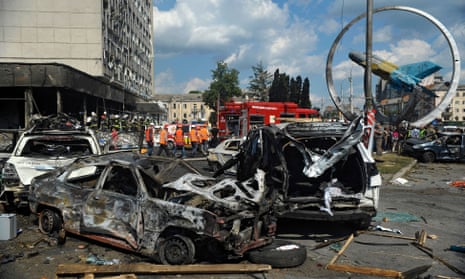A top Ukrainian official has accused Russia of deliberately escalating its deadly attacks on civilian targets, after recent missile strikes including this week’s targeting of the crowded city centre of Vinnytsia, which killed 23 people, including three children.
Oleksiy Danilov, the secretary of Ukraine’s national security council, told the Guardian that monitoring of Russian strikes suggested an increased emphasis in recent weeks on terrorising Ukraine’s civilian population.
“We have a system to monitor and track all airstrikes and other attacks in our country and what we have noticed recently is a tendency to destroy more and more civilian targets. They have decided to terrorise civilian population. That’s not my emotions but what our monitoring is telling us.”
While Russia has been accused of targeting civilians throughout its invasion of Ukraine, missile strikes on civilians and civilian infrastructure appear to have increasingly become a distinct tactic with a string of deadly attacks over the past month.
An attack on a shopping mall at Kremenchuk, a small city on the Dnieper river, at the end of June killed 18 people and injured 59. An apartment block and beach hotel in Serhiivka, 50km south of Odesa, was hit on 1 July, killing 21 people and injuring 35.
Two apartment buildings in Chasiv Yar, near the frontline in Donetsk oblast, were hit on 9 July: 48 people are believed to have been killed, making it one of the deadliest single attacks in the entire five-month long war. Vinnytsia, a central city far from the frontlines, was struck on Thursday, five days later.
Danilov suggested that some attacks – including during a visit by the UN secretary general, António Guterres, to Kyiv – appeared designed to deliver a message of defiance. Thursday’s attack in Vinnytsia took place as European ministers sat down in The Hague to discuss how to hold Russia accountable for atrocities committed during its invasion of Ukraine.
“We have an enemy that breaks all the rules of war and rejects international law so we cannot expect any better behaviour,” said Danilov. “What I am surprised by is the fact that a country that rejects international law is allowed to participate in international institutions to claim its ‘rights’.”
A multiple missile attack on Kyiv’s university district on 26 June, just as the G7 summit was beginning – and after an EU summit had just concluded – was interpreted as an attempt to intimidate Ukrainians and show that Russia did not fear the west. It was the first time the capital had been hit for three weeks.
Dr Sidharth Kaushal, an analyst from the Rusi thinktank, said that Russia had used long-range missiles, capable of hitting anywhere in Ukraine, for two purposes: either “disrupting the flow of supplies to the frontline or the terrorisation of civilians”. Recent strikes, he added, “suggest an emphasis on the latter function both because their targets were clearly nonmilitary”.
Some of the missiles used have been from the Soviet era – and used in a manner not intended by their original design. Kaushal said that at Kremenchuk, Russia used a AS-4 “kitchen’ anti-ship missile first deployed in the 1960s. Amnesty International said the same munition was used in the double missile strike in Serhiivka – indicating, Kaushal added, that “the goal is terror, not precision”.
Ukraine’s missile defence systems are limited, with early warning capabilities lost in the early stages of the war. Its system of air raid warnings is largely ineffective, and sirens in cities outside conflict zones are rarely followed by attacks. To improve the situation, Kyiv has sought to obtain defence systems from the west – receiving limited supplies so far.
At the beginning of July, the US promised to supply two US-Norwegian Nasams air defence systems, which operate with a range of about 20 miles, suitable for protecting Kyiv or another major population centre. But Russia’s recent wave of missile strikes have been focused on secondary or tertiary centres.
Konrad Muzyka, a military analyst and director of Rochan Consulting, said he believed the increasing Russian strikes were linked to Ukraine’s use of longer-range multiple-launch rocket artillery systems, principally the newly arrived Himars truck-mounted battery from the US.
“The more successful Ukrainians will be with their employment of Himars, the more likely Russians are to target civilians,” Muzyka said, arguing that Moscow’s tactics were in effect a crude attempt at deterrence, designed to weaken Kyiv’s desire to counterattack and kick the invaders out.
Danilov rejected this interpretation. “You cannot connect the arrival of Himars with these strikes. Even if we did not have those systems they would still be terrorising and killing the civilian population so that linkage risks being a Russian narrative.”
A security alert released overnight on Thursday, headlined Missile Threat Awareness, once again advised Americans to leave Ukraine. It added: “Avoid large gatherings and organised events as they may serve as Russian military targets anywhere in Ukraine, including its western regions.”
The latest attacks have coincided with intercepted messages and social media posts by Russian servicemen and pro-Russia bloggers explicitly celebrating the strikes on Ukrainian civilians.
On Friday Russia acknowledged it had targeted the centre of Vinnytsia, claiming the target was a meeting of Ukrainian officials and western arms dealers but without providing any evidence. Previously, pro-Kremlin sources had denied hitting Vinnytsia, claiming another town had been hit.
